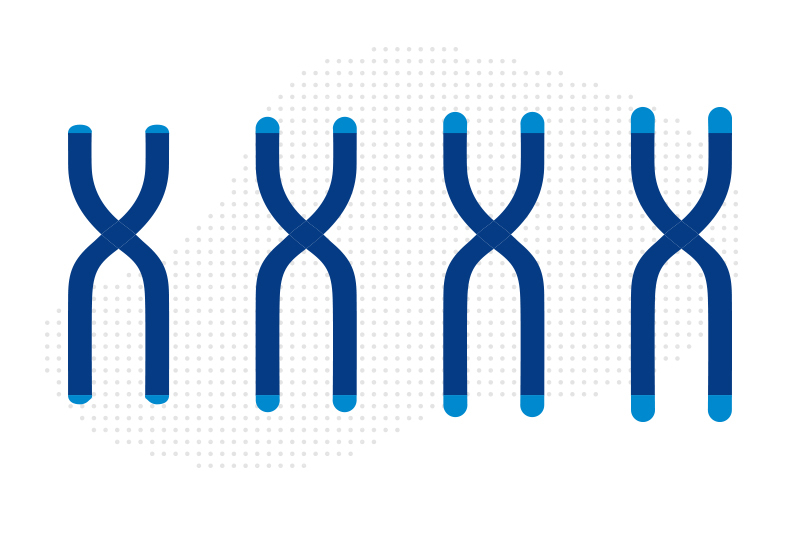Dyskeratosis Congenita | Symptoms & Causes
What are the symptoms of dyskeratosis congenita?
Dyskeratosis congenita (DC) symptoms and the onset of symptoms vary among those affected. In some individuals, the condition may be mild and in others more severe.
Characteristically, the signs and symptoms include:
- abnormalities of the skin, such as unusual pigmentation with a net-like pattern on the neck and upper chest
- defects in fingernails and toenails, including cracking, splitting, and underdevelopment or distortion
- oral lesions that appear as white patches in the mouth
The absence of these classic symptoms does not rule out DC, and depending upon the severity, some individuals may have other potential complications, such as:
- bone marrow failure
- lung disease
- cancer
- liver disease
Eventually, most people with DC will develop bone marrow failure. It may happen in early childhood, during adolescence, or it may not occur until adulthood.
What causes DC?
The underlying cause of DC is the presence of shortened telomeres. Telomeres protect genetic data. Like the plastic tip on the end of a shoelace, telomeres keep chromosome ends from fraying and fusing together, while allowing cells to divide.
Each time a cell divides, the telomere shortens, and when they become too short the cell stops dividing. People with DC have a gene abnormality that disables their ability to maintain telomeres. Their cells stop dividing too early, resulting in failure of their organs and disease.
DC is most often inherited, passed from parent to child, although, some parents may never show signs of the condition. Less often, it is not inherited but rather a new gene mutation in the child.
Dyskeratosis Congenita | Diagnosis & Treatments
How is dyskeratosis congenita diagnosed?
Because people have different symptoms at different points in their lives, it is often difficult for doctors to diagnose dyskeratosis congenita (DC). If the condition is suspected following a clinical evaluation and detailed family history, your physician may order some or all of the following tests:
- Blood counts: A complete blood count (CBC) can help your doctor to understand the cause of low blood counts. Individuals with DC typically have an abnormally low number of red blood cells, white cells, or platelets.
- Bone marrow exam: A bone marrow biopsy will be performed to allow your doctor to look for marrow abnormalities, such evidence of pre-cancerous or cancerous cells.
- Telomere length test: A blood test sent to a specialized lab can measure the length of telomeres in the DNA of blood cells and compare that result to unaffected individuals of the same age.
- Other tests: Additional tests, as well as genetic testing may be ordered to rule out other inherited conditions, such as myelodysplastic syndrome (MDS).
What are the treatment options for DC?
The treatment plan for DC is dependent upon the individual and the progression of their illness. Milder forms of DC may not require treatment for many years. For those who have a more severe form of the condition, there are a couple of treatment options available.
Androgen therapy
Steroid drugs, known as androgens, can improve blood counts in individuals with DC. The benefits of androgen therapy are only temporary, and the length of time this treatment improves bone marrow function varies.
Stem cell transplantation
If a compatible donor can be found, a stem cell transplant, also known as a bone marrow transplant, potentially can cure the blood abnormalities associated with dyskeratosis congenita. Stem cell transplant does not, however, improve tissues affected by the condition.
How we care for DC
Our Bone Marrow Failure Treatment Program at Dana-Farber/Boston Children's Cancer and Blood Disorders Center has a specialized team that focuses on the treatment of children, adolescents, and young adults with DC. This team is comprised of clinicians from a range of specialties, including those in our world-renowned Pediatric Stem Cell Transplant Program.
We have access to the most advanced treatments and diagnosis, including genetic mutation identification and ongoing clinical trials investigating new treatments. Our team is personally invested in finding solutions for those looking for answers.
Dyskeratosis Congenita | Research & Innovation
Our areas of research for DC
We are using our vast resources within Dana-Farber/Boston Children's to find new ways to improve the lives of people with dyskeratosis congenita. Our research involves a comprehensive range of activities, including:
- improving diagnosis
- creation of the Clinical Care Consortium for Telomere Associated Ailments (CCCTAA) to facilitate multi-institutional clinical and translational research and improve care for patients with DC and other telomere biology disorders.
- stem cell transplant clinical trial to test the safety and efficacy of SCT for dyskeratosis congenita without using radiation or alkylators (expected to significantly decrease short- and long-term toxicities)
- pediatric myelodysplastic syndrome (MDS) and Bone Marrow Failure (BMF) registry, an National Institutes of Health-supported collaborative research effort established at Dana-Farber/Boston Children’s in 2009 to identify DC genes
- research on the genetics and mechanisms of disease in DC, as well as new treatment approaches
- development of novel small molecule and genetic treatments


